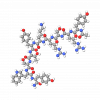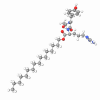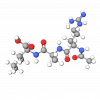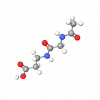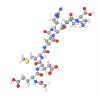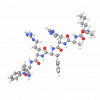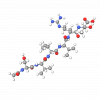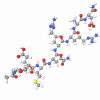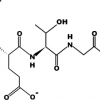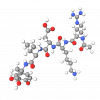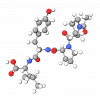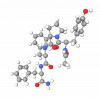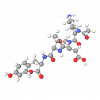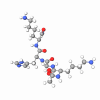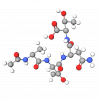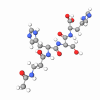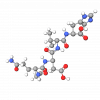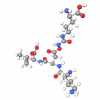Peptides
There are numerous examples in physiology of peptide regulatory elements that play integral roles in basic homeostatic mechanisms such as injury-repair responses and other stimulus-response actions. Among these are well-known neuropeptides (e.g., bradykinins, endorphins); metabolism and fat storage regulators (e.g., neuropeptide Y, leptin, insulin); tanning and skin pigmentation-related peptides (e.g., α-MSH, ACTH, Agouti), and peptides involved in wound healing (e.g., FGF).
This large group of innovative cosmeceutical ingredients triumphed in the world of skincare products during the last two decades. Peptides are chains of amino acids that are attached in a specific order. Amino acids are naturally occurring in the body and are vital to everyday living processes. Peptides can be made up of 2 or more amino acids that can stimulate different responses within the body. As a result, peptides serve as tiny messengers that can be sent to kick the skin into gear and make it look better.
Peptides are leading a beauty revolution due to their excellent multi-functional properties; formularies are scrambling to access the latest advances in cosmetic peptide technology. In addition, their "Botox-like" performance, activation of collagen and elastin production, and skin-lightening effect make them very efficient against coarse wrinkles and hyperpigmentation of the skin.
Acetyl Cyclohexpeptide-34 is a synthetic lipopeptide that recognizes and acts selectively on adipocytes (fat cells) and is used in advanced complex X50® Silhouette as a targeting peptide (Cosmetic Drone® technology).
Acetyl decapeptide-3 is a synthetic peptide (known under the trade name CG-Rejuline) that repeats the part of the sequence (Ac-tyr-arg-ser-arg-lys-tyr-thr-ser-trp-tyr-NH2; YRSRKYTSWY) of bFGF - Basic Fibroblast Growth Factor (or Fibroblast growth factor 2; FGF-β) protein and mimics its
Acetyl Dipeptide-3 Aminohexanoate (sequence Ac-Arg-Ala-Ahx-OH) also known under the trade name Bodyfensine® is a tripeptide that boosts the skin's natural peptidic protection against harmful microbes.
Acetyl Glycyl Beta-Alanine is a synthetic peptide, a multifactorial skin whitening agent that suppresses different steps of melanin production. It is known under the trade name GenoWhite™.
Acetyl Heptapeptide-4 is a synthetic peptide with sequence Ac-Glu-Glu-Met-Gln-Arg-Arg-Ala that was developed to maintain the skin's microbiota balance. It promotes the growth of beneficial bacteria acting as a probiotic while boosting skin's natural defense systems against harmful microbes.
Even if gray hair can be a fashion statement, many people desire lustrous colorful hair. As we age, the hair follicles produce less melanin, the pigment responsible for hair color, so progressively hair become gray.
Acetyl Hexapeptide-37 (known under the trade name Diffuporine™) is a synthetic peptide found by combinatorial peptide screening technology. Scientists from Lipotec S.A. monitored human keratinocyte cells treated with peptides that can produce luminescence when in contact with the luciferase.
Acetyl Hexapeptide-38 is a synthetic peptide (with sequence Ac-Ser-Val-Val-Val-Arg-Thr-NH2) found with screening methods and using the reporter gene assay from millions of other hexapeptides with different
Acetyl Hexapeptide-39 is a synthetic peptide that acts as an antagonist of PGC-1α (Peroxisome proliferator-activated receptor-gamma coactivator) protein responsible for adipocyte differentiation and maturation.
An organism's ability to repair DNA damage is correlated with its longevity. The DNA repair process is a very important capacity that induces cell survival and, at the same time, the need to activate solutions that avoid errors in its replication.
Acetyl Octapeptide-17 Amide is a synthetic peptide that mimics a functional part of EGF (Epidermal Growth Factor) with sequence Ac-Met-Leu-Lys-Glu-Trp-Glu-Leu-Arg-NH2. It is known under the trade names Dermacurin and Mini EGF.
Acetyl sh-Heptapeptide-1 is a modified synthetic recombinant peptide with sequence Ac-Asp-Glu-Glu-Thr-Gly-Glu-Phe, that repeats a part of a sequence of Nrf2 protein that acts as a self-protective master switch that prevents extrinsic and chronological aging.
Acetyl sh-Hexapeptide-5 Amide Acetate is a derivative of a synthetic peptide derived from Versican proteoglycan (glycosylated protein). Versican is present in the extracellular matrix (ECM) of many human tissues and organs, including skin, where it performs many functions.
Acetyl sh-Pentapeptide-1 (former Acetyl Pentapeptide-1 with the sequence Ac-Arg-Lys-Asp-Val-Tyr-OH) is an acetylated and stable derivative of sh-Pentapeptide-1, a Thymopoietin peptide that mimics immunomodulatory protein action.
Acetyl Tetrapeptide-15 is a peptide ingredient based on a unique mechanism of action, mainly targeting neuro-sensitive skin, able to reduce the nerve response to external stimuli.
Acetyl Tetrapeptide-2 is a synthetic peptide (sequence Ac-Lys-Asp-Val-Tyr) with proven effects in combating skin sagging. It helps to stimulate the skin's fundamental proteins, such as collagen and elastin, facilitating and improving cohesion between cells and the ECM (extracellular matrix).
Acetyl tetrapeptide-3 is a biomimetic peptide derived from a growth factor, also known by the trading name Folixyl®.
Acetyl Tetrapeptide-40 is a synthetic peptide that decreases the realize of pro-inflammatory interleukins (IL-6 and IL-8) fighting against skin redness, erythema, and telangiectasias. It is known under the trade name Telangyn™ and the sequence is Acetyl-Ala-Thr-Asn-Thr.
Acetyl Tetrapeptide-9 is a synthetic peptide that mimics Lumican's matrikine function regulating fibroblast activities. The ingredient stimulates the skin's natural regeneration mechanisms so that it not only looks young but also feels young. The peptides' sequence is Ac-Gln-Asp-Val-His-OH.
Acetyl Tripeptide-30 Citrulline is a synthetic peptide (known under the name Peptide AC29 with sequence Lys-α-Asp-Ile-Citrulline) that prevents the degradation of extracellular matrix components through the inhibition of MMP (metalloproteinase) enzymes.
Acetyl Tripeptide-54 Amide is a low molecular weight lipo-peptide (known under the trade name Adiponin™) derived from Adiponectin, an adipose-tissue-specific releasing adipokine.
NF-kB is a transcription factor involved in the proinflammatory responses causing skin aging and inflammation. Acetyl Tripeptide-74 Amide is a lipo-peptide that inhibits NF-kB activity and acts as a skin soothing, anti-inflammatory, and anti-photo-aging agent.


